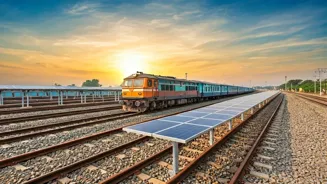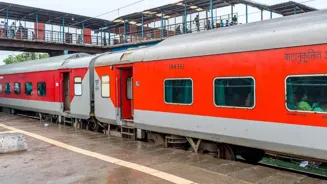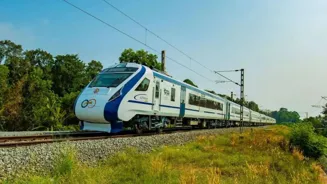Indian Railways has unveiled its ‘Solar Track Project’ in Varanasi, Prime Minister Narendra Modi’s parliamentary constituency, making it the first city where electricity is being generated from solar panels
installed between railway tracks. The pilot initiative at Banaras Locomotive Works (BLW) is expected to significantly aid emission cuts and support the 2030 net-zero goal.
The removable solar panel system covers a 70-metre stretch of track at BLW’s workshop line number 19. With 28 indigenously designed solar panels generating a total capacity of 15 kilowatt peak (KWp), the installation promises both innovation and efficiency without disrupting the movement of trains.
Announcing the milestone, the Ministry of Railways shared a post on X (formerly Twitter), saying: “Banaras Locomotive Works, Varanasi commissioned India’s first 70m removable solar panel system (28 panels, 15KWp) between railway tracks—a step towards green and sustainable rail transport.”
🚆 Indian Railways marks a historic first!
Banaras Locomotive Works, Varanasi commissioned India’s first 70m removable solar panel system (28 panels, 15KWp) between railway tracks—a step towards green and sustainable rail transport. pic.twitter.com/BCm2GTjk7O— Ministry of Railways (@RailMinIndia) August 18, 2025
Unlike conventional rooftop or ground-mounted solar plants, the BLW system places panels directly between tracks, secured with rubber mounting pads and epoxy adhesive. This avoids the need for additional land acquisition—a common hurdle in renewable energy projects. Officials with BLW, while highlighting the specifications of the project told News18 that each panel, measures 2278 mm in length, 1133 mm in width, and 30 mm in height, weighs about 31.83 kg. “Designed with bifacial mono-crystalline PERC collar cells, the panels can capture sunlight from both sides, improving efficiency. The installation allows panels to be removed and reinstalled within an hour and a half, ensuring easy access for railway track maintenance,” the official said.
According to railway officials, several engineering challenges were considered before rolling out the project. These included vibrations caused by passing trains, dust accumulation, and the requirement for quick removability during maintenance. To address this, rubber pads were used to reduce vibrations, while epoxy adhesive ensured a strong bond with concrete sleepers. Panels are fastened using stainless steel Allen bolts, making them easy to detach whenever required.
On the electrical side, each panel generates around 602 Wp at peak with an open circuit voltage of nearly 50 volts and module efficiency ranging between 20–21 percent. With an operational track length of about 1.2 lakh kilometres, Indian Railways sees immense potential in replicating the Varanasi model nationwide, especially across yard lines and unused stretches. Officials estimate that the scheme can generate up to 3.21 lakh units of solar power annually per kilometre without requiring any land acquisition.
If scaled across the network, the initiative could significantly cut electricity costs and carbon emissions, further aligning Indian Railways with the government’s renewable energy and climate change mitigation goals.
On the durability of the panels, the officials said that the panels are resistant to dust and debris accumulation and can be cleaned easily due to their accessibility. The estimated payback period for the installation is around seven years, after which the system is expected to contribute free and clean electricity for many years.
“This is the first time in India that solar panels have been successfully installed between railway tracks without disturbing train operations. What makes this initiative unique is that it uses entirely indigenous design and technology. We expect that per kilometre, such systems can generate up to 3.21 lakh units annually. If implemented on a larger scale, this could be a game-changer for Indian Railways in meeting its net-zero carbon emission goals,” said Rajesh Singh, Public Relation Officer (PRO), Banaras Locomotive Works.
Singh also highlighted the ease of maintenance. “These panels can be removed within 90 minutes whenever track work is required, which makes them highly practical for regular railway operations,” he added. He said that the solar track project is not just an experiment in renewable energy but a potential blueprint for Indian Railways’ sustainable future. If replicated widely, the initiative could transform India’s vast railway network into a sprawling solar energy corridor, further reinforcing the government’s commitment to renewable energy and climate action.
Technical Specifications
Track length covered: 70 metres
Installed capacity: 15 KWp
Number of solar panels: 28
Power density: 240 KWp/km
Energy potential: 960 units per day per km
Module efficiency: Over 20 per cent











